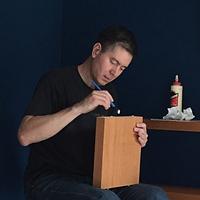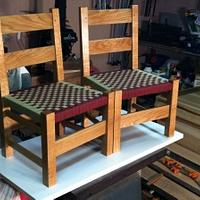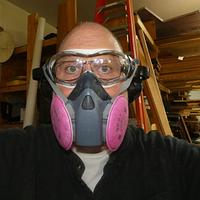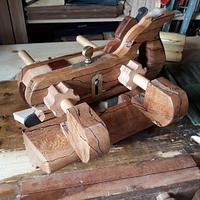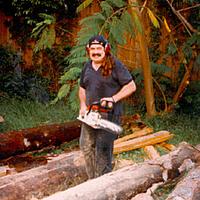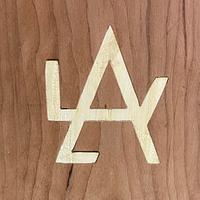
HokieKen
in about 3 years
How I Sharpen #1: Sharpening Methods - Introduction
This is
part 1
in a
6 part
series:
How I Sharpen
I do want to state up front that the methods and tools presented in this series are MY chosen methods. They are by no means the only options or even the best options. They're just what works for me to obtain the results that I'm happy with. Also, you'll see a lot of powered sharpening and I know that not everyone has, or wants, a Worksharp or a 2x72 belt grinder available. But when I use a powered tool, the methods can be applied to sharpening the same tools on oil stones or diamond plates. I will try to remember to point out how certain things can be done manually if you sharpen that way but no promises that I won't forget to do that more often than not 😉
There are so many possible ways to sharpen and I doubt many of us have access to every one of them. I certainly don't. But below I'll list the ones I use most frequently.
- "Oil Stones". I have a lot of different natural stones I use for a lot of different purposes. The majority of them are small and are used for machining so you probably won't see those much, if any, in this blog series. But I do have a variety that I use for woodworking tools. These are all generically referred to as "Oil" stones because you need to lubricate them when you sharpen with them to prevent clogging and to keep the metal swarf from becoming embedded in the porous surfaces. The best lubricant is one of those things that is widely debated. Recommendations range from water to gasoline. Personally I use mineral oil but I don't feel strongly about it. I've used water (don't use water on a stone that has been oiled previously, it won't get into the pores) and kerosene and special "sharpening oil" blends that you can buy. I don't really see any difference.
- Arkansas Stones. These are natural oil stones used for sharpening. I have bench stones and slipstones (small stones with odd geometries) in Soft (coarse) Hard (medium) Black (fine) and Translucent (very fine). I use these primarily for free hand sharpening knives. But, if that's what you have, they will work fine for sharpening most woodworking tools, they're just slower cutting any harder to use with something like a honing guide because they wear and go out of flat relatively quick compared to other mediums.
- India Stones. These are similar to Arkansas stones in use but rather than being naturally occuring and quarried and processed, India stones are an Aluminum Oxide formed with a binder. Similar to sandpaper or a bench grinder wheel. I rarely use these and the ones I have are mostly smaller ones used to fine-tune cutting tools for machining. But they can be used generally interchangeably with Arkansas Stones. This is most likely the only mention you'll see of these in my blog but be aware that if you have them, anywhere I mention Arkansas Stones, you can do the same thing with India stones. They do cut notably faster than Arkansas stones so they are a good option if you are grinding a cutting edge from a blank or heavily modifying an existing cutting edge. But they make a heckuva mess and even the fine grades don't produce what I would call a finished edge. If you use India stones, I highly recommend picking up a Black Arkansas stone to compliment them and use it to finish the final edge.
- Carborundum Stones. These are manmade stones similar to India Stones but they're made of Silicon Carbide. My SiC stones get used exclusively on HSS machining tools. They cut really fast and are a good option for fast material removal. But even the fine grade doesn't produce even an acceptable cutting edge for woodworking tools IMO. If you have these, they are fine for removing chips from an edge or modifying/creating new geometry but I would switch to a different medium to sharpen and finish your final edge.
- Diamond Plates. Most woodworkers are familiar so I won't say much here. They're just diamond particulate of different sizes bonded to a (usually) steel plate. I prefer ones that are a flat surface without holes or grooves. And in general I would steer clear of the cheap ones. Quality diamond plates have the abrasive embedded in a plating that is bonded to the steel. Cheaper versions have the abrasive bonded to the substrate with an adhesive. The longer and wider the better if you are going to use a honing guide for things like chisels and plane blades. I have a set of DMT Dia Sharp in coarse, medium, fine, and X fine. I definitely recommend them but they are by no means the only good ones available. Good diamond plates can be a hefty investment but diamonds can sharpen almost anything (and certainly anything used for woodworking) and will likely last for life in a hobby shop. Until I got a Worksharp, I used my diamond plates for practically everything. Lubricate them with water or glass cleaner or you can buy special fluids.
- Diamond Hones. Essentially the same as the plates and work the same way but I have smaller ones and diamond needle files for specialty uses. I don't use them often other than a small flat one for touching up the edges of carbide router bits.
- Sandpaper. A lot of people overlook this as a perfectly good sharpening media. I use it primarily for freehand sharpening when I need to work an edge that isn't flat. But google "scary sharp" and you'll see you can use it from rough shaping all the way to a finished edge with excellent results. For woodworking tools, you'll probably want to have a hard, flat substrate like a piece of glass or a granite plate. When I started using sandpaper several years ago, I went to Home Depot and bought about a dozen smooth granite tiles and took them home and used a straight edge to find dead flat ones. I kept two and returned the rest. Sandpaper is available in grades from very coarse to exceptionally fine (ultra fine grades are usually called lapping films) and can fit the bill for most any woodworker's sharpening needs. The downside is that you have to change it frequently and find a way to bind it to your substrate so it can be time consuming and in the long run if you have a lot of tools you sharpen frequently, it can get expensive.
-
Powered Sharpeners. I won't go into a lot of detail here because these will probably be pretty prolific in the following blog entries.
- 2x72 Belt Grinder. I built mine but there are a variety available for purchase and they can be had in different sizes. A hefty investment and IMO overkill for sharpening but I made mine for other uses so I use it for some sharpening when it's the best choice.
- Work Sharp 3000. You'll see this a lot in this series. Far and away my preferred method for most everything these days. My diamonds are getting lonely.
- Bench Grinder. I don't use this much in general because I don't like hollow grinds but it's used almost exclusively for HSS tools. You're bound to see my setup in posts about turning tools.
So that's the background. The meat and potatoes will be in future installments.
36 Comments
Ryan/// ~sigh~ I blew up another bowl. Moke told me "I made the inside bigger than the outside".
working with my hands is a joy,it gives me a sense of fulfillment,somthing so many seek and so few find.-SAM MALOOF.
The Other Steven
"Duck and Bob would be out doin some farming with funny hats on." chrisstef
If it’s not already in your plans, I’d really like to hear your thoughts on what a minimal, low-cost setup might be. I have one dual-sided diamond stone for my chisels, but I don’t think I’ve ever gotten them truly sharp.
"Duck and Bob would be out doin some farming with funny hats on." chrisstef
"Duck and Bob would be out doin some farming with funny hats on." chrisstef
You’re a brave man, good one too!
Looking forward to this.
Watch and learn, practice and learn, create and learn
I, obviously, approach sharpening from the Neanderthal side of things, although I have switched to cheap diamond stones for plane irons, I still prefer the oil stones for chisels though. Still working out what I like best for moulding planes and gouges though.
I freehand sharpen, but it was just a masochistic challenge, took a stupidly long time to learn & it's not notably quicker than using a guide, relatively speaking, an extra 20 seconds to set up the jig doesn't matter.
And I second a strop with some honing paste. Honestly, I rarely sharpen, but I constantly hone (like several times in a basic project) and it keeps the blades very keen for a long time. I hone freehand on the WorkSharp since there’s no concern about changing a bevel with a strop, and my WS lives, set up and ready, on the bench so it’s super convenient.
Ryan/// ~sigh~ I blew up another bowl. Moke told me "I made the inside bigger than the outside".
Mike
Yooper with a Drawl
The Other Steven
I do most of my coarse sharpening and repair on a Sorby Proedge belt sharpening system. I can change or create a bevel or fix a nick or gouge very quickly this way. Before I bought the Proedge, I did it on a 6x48 belt sander that I made specifically because I wanted to to use it for sharpening my turning tools. I really hate sharpening them on a bench grinder. I much prefer the edge I get using a flat grind on turning tools than I you get with a round grinding wheel. (About the only thing I use my bench grinder for is de-burring metal pieces I cut.) Sharpening turning tools might be a good chapter to include. Sharpening guides and jigs might also be a good topic.
--Nathan, TX. Hire the lazy man. He may not do as much work but that's because he will find a better way.
The cardboard is from a Cheerios cereal box
Another roaring endorsement for my childhood favorite cereal!
Nathan, I’ve seen some sharpening stone station layouts that seemed reasonable, mostly by creating hold downs to secure the stones to a board (I think they’re were actually recesses cut into the board that the stones set it), and the board being portable. So you reach under the bench, pull out the board with the stones on it and place it atop a side table (or the bench) and you’re ready to sharpen. Being thin, you might be able to build a high shelf under the bench to slide it into for storage without giving up too much room.
When it comes to all this stuff, for me, accessibility is the key. I’m an inherently lazy individual, so if things are set up and ready to go, I’ll use them. If I have to set them up, they simply get less use.
The perfect example is yesterday: My wife wanted me to make her a puzzle board with a small border around the edge to keep pieces from sliding off. Based on the size of the board, it was really cumbersome to try to cut the very thin strips on the table saw. I probably could’ve set them up to do them on a bandsaw, but the board is so flexible that I was having a hard time keeping it flat. The correct tool in this case was to use the track saw, and I knew it as soon as I started thinking about how to cut the strips, but my tracks hang up above my garage door, as does the large panel of insulation that I use as a table for it. And since the garage door was already up, that meant lowering the garage door to then climb up to get the pieces to then bring them down. Of course, in my head, then I have to put all that stuff away afterwards. So I suffered on for about 15 minutes, and screwed up about three cuts before I finally gave up, close the damn door, pulled down the right gear, finished the perfect cuts that I needed, and put it all back probably within less than 10 minutes. I fought with it for probably a total of almost an hour when I should’ve just used the damn thing in the first place. But, because it wasn’t already set up and easily accessible. I put it off. What’s worse is I told myself ‘you’re being an idiot, just pull down the damn tracksaw’, but alas, I’m a dumbass. But that proves my point at least in my head…
Anyway, for me, accessibility is key…which can be tough to come by in a small shop!
Ryan/// ~sigh~ I blew up another bowl. Moke told me "I made the inside bigger than the outside".
As a kid I always used Dad's hardware store grey composite stone that everyone has 5 or 6 of lying around, then a "finish" with his white Arkansas (this was all for pocket knives).
My first "real" improvement was a two sided Arkansas (black/white) which I hate, doesn't ever seem to remove any metal.
Went with the various grades of SiC paper up to 2500 on a cheap HF surface stone which I still use and I have a fresh set of diamond plates and most recently a #8000 Shapton ceramic.
I still hate sharpening! 🧐













